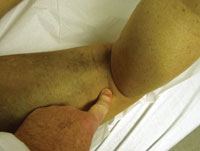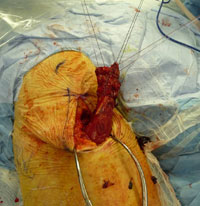Proximal hamstring injuries can have significant disability
Surgery is indicated for younger athletes with a positive bowstring sign and greater than 5 cm displacement.

Rupture of the proximal origin of the hamstrings is an uncommon injury and many orthopedists never see a case, or if they do, it is infrequently. The important aspect of the care is making the diagnosis and then making a recommendation to your patient. Russell F. Warren, MD, and his associates recently published an excellent article on this topic. For this month’s 4 Questions interview, I have asked Dr. Warren to share what his group has learned from their study and how the results can be applied to clinical practice.
Douglas W. Jackson, MD
Chief Medical Editor
Douglas W. Jackson, MD: How is the diagnosis of a rupture of the proximal origin of the hamstrings made clinically?
Russell F. Warren, MD: Proximal hamstring injuries, while less common than mid-hamstring tears, can have significant disability. Often, they will present with a history of sudden knee extension and hip flexion as in waterskiing or slipping on a wet floor. The patient will note immediate pain/tenderness at the ischial tuberosity. On occasion, a history of prior chronic irritation from tendinosis will be given when:
|
|
- parasthesis from the sciatic nerve may be noted;
- examination demonstrates limited straight-leg raising in most, while some may have 20° to 30º of increased motion on the straight-leg raising exam; and
- a defect may be palpable as patients attempt to extend their hip or a muscle bulge in the mid thigh in a complete avulsion; or
- variable degrees of weakness on resisted knee flexion while lying prone are noted. The hamstrings should be palpated and their tension noted as compared to the opposite knee. If tension is poor, then it is called a positive bowstring sign indicating a significant elongation of the muscle tendon unit that patients cannot overcome and will likely lead to significant post injury weakness.
Jackson: What findings on an MRI exam confirm the diagnosis?
Warren: X-rays are often negative but in adolescents, a boney avulsion with an apophyseal separation is seen.
MRI is of great value in delineating the degree of injury. The picture should include the ischial tuberosity and proximal half of the thigh. The injury will pull off the semimembranosus from the lateral side of the ischial tuberosity and the semi-tendinosis and biceps more distally. Injury may be partial with minimal separation or complete with displacement up to 10 cm to 15 cm. A large hematoma is often present and an attempt to measure displacement should be made. The low signal tendon lies adjacent to the sciatic nerve, which may develop symptoms.
|
|
Images: Warren RF |
Jackson: What are the indications for surgery and what can the patient expect in terms of rehabilitation and outcomes?
Warren: Surgical indications will vary with age and activity, but surgery is recommended in younger, active patients with a positive bowstring sign and displacement of greater than 5 cm. The degree of separation should be assessed with an MRI. If the tendon rupture is complete and greater than 5 cm in younger athletes, then primary repair is recommended. Generally, the exam will note a positive bowstring sign suggesting weakness will persist. Partial defects occur and may heal. Tendonosis occurs and may precede a rupture.
If the tendon is displaced less than 2 cm, then healing is likely, while with a 2-cm to 5-cm displacement, it is probably best to repair in a young patient. In older less active patients, observation is of value. There is tendency for a scar to form and re-attach the tendons over time, but it is not predictable and can take months to rehabilitate, so surgery is likely to be of significant benefit in active patients.
It is important to decide early as delays in surgery of greater than 3 weeks will make dissection more difficult as the sciatic nerve can become enmeshed in the scar tissue. In patients where there is a delay of more than 4 weeks, the dissection is best done with someone who is experienced in nerve dissection.
Jackson: What surgical approach, exposure and repair is used for an ideal repair?
|
|
Warren: The surgical approach can be a vertical distal to the gluteal crease, which I prefer, particularly if there is a delay in repair. Some prefer a transverse incision but this may limit your exposure if the displacement of the tendon is marked.
The exposure should preserve the cutaneous nerve that lies deep to the fascia and then the hematoma is evacuated exposing the ruptured tendons. The sciatic nerve with branches entering the hamstring muscle proximally is identified and generally dissected off the tendon on the posterior lateral corner. With chronicity, this dissection can be difficult.
Once the nerve is freed from the tendon, the tendon is advanced proximally to note the length. Further dissection to free up the tendon in chronic cases will be necessary. The ischial tuberosity is curetted and freshened for tendon reattachment. Two #2 Orthobond sutures are placed in a Krackow fashion and then one end of the suture is place in an anchor that is inserted in the ischial tuberosity. Generally spacing them about 1inch apart along the lateral side, the anchor is used as a pulley to advance the tendon to the tuberosity. The wound is closed precisely to avoid a slow healing process and meticulous hemostasis maintained as I prefer not to use a drain.
A hip spica is applied with the hip at 0° to 40° depending on the degree of fixed retraction — the knee is not included. The brace is worn for 6 weeks, but is removed to shower, and the patient can put most of their weight on the leg. Muscle rehabilitation and restoration of motion follow with sports participation delayed for about 4 months to 5 months.

- Russell F. Warren, MD, can be reached at 535 East 70th St., New York, NY 10021; email: WarrenR@hss.edu.
- Disclosure: Warren receives royalties from Biomet and Smith & Nephew; has stock or stock options in Cayenne, Orthonet and Regen Biologics; and receives royalties from Wolters Kluwer Health and Lippincott, Williams and Wilkins.




